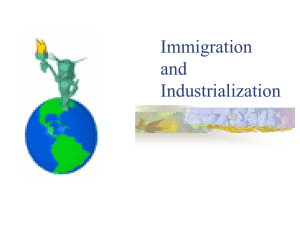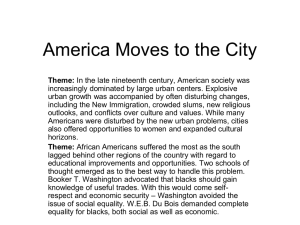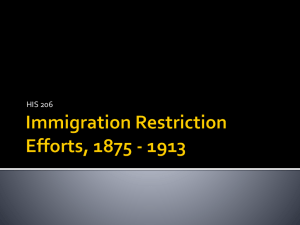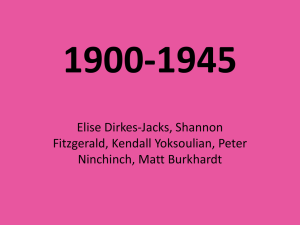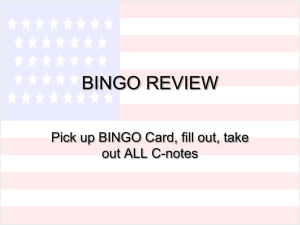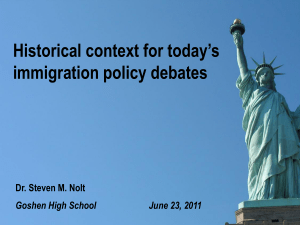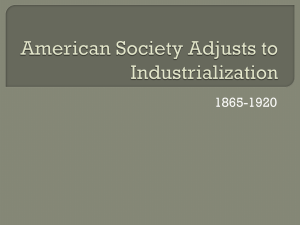Foreign Policy Objectives and U.S. Immigration Policy
advertisement
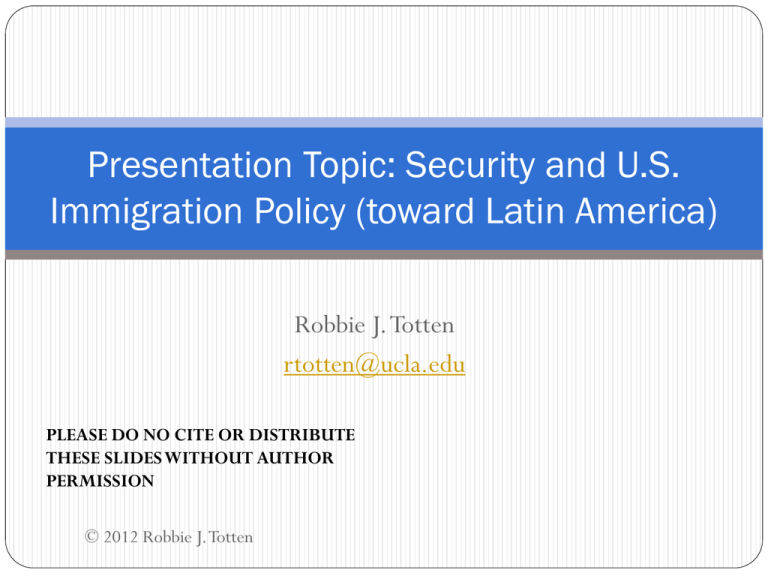
Presentation Topic: Security and U.S. Immigration Policy (toward Latin America) Robbie J. Totten rtotten@ucla.edu PLEASE DO NO CITE OR DISTRIBUTE THESE SLIDES WITHOUT AUTHOR PERMISSION © 2012 Robbie J. Totten Class Question: What comes to mind when you think, “Security and U.S. Immigration Policy?” © 2012 Robbie J. Totten Broad Introductory Questions: Is this (border security, unauthorized (“illegal”) immigration, terrorism) how we typically think of security and U.S. immigration policy??? Is there more to the security/immigration story??? Introductory Perspectives Two Very Different Viewpoints Regarding Security and U.S. Immigration Policy What is going on here? • Statue of Liberty Inscription--Emma Lazarus Poem: "Give me your tired, your poor, Your huddled masses yearning to breathe free, The wretched refuse of your teeming shore. Send these, the homeless, tempest-tost to me, I lift my lamp beside the golden door!" Nixon and Kissinger on if the U.S. should offer persecuted Jews in the Soviet Union refuge in America: Kissinger stated privately that, “The emigration of Jews from the Soviet Union is not an objective of American foreign policy.” “And if they put Jews into gas chambers in the Soviet Union, it is not an American concern. Maybe a humanitarian concern.” Nixon responded to his remark by saying, “I know. We can’t blow up the world because of it.” (Nixon Tapes, February 13, 1973) © 2012 Robbie J. Totten Introductory Definitions: Security/U.S. Immigration Policy Big Distinction by How one Conceptualizes and Understands “Security” U.S. Immigration Policy (Layman’s Terms): America’s decisions regarding which (and on what terms) foreign citizens (both authorized and unauthorized foreign nationals) get to enter/exit U.S. borders. National Security “refers to the requirement to maintain the survival of the nation-state through the use of economic, military and political power and the exercise of diplomacy.” (your standard IR textbook) Human Security (from IR textbook) “is people-centered and its focus is on protecting individuals.” Puts forth that “the proper referent for security should be the individual rather that the state.” (your standard IR textbook) © 2012 Robbie J. Totten Security and U.S. Immigration Policy: Question to Guide Today’s Presentation: What are the security objectives that U.S. leaders have historically attempted to reach with immigration policy? © 2012 Robbie J. Totten Outline of Presentation Today: 1. Why should we care about this question/topic? 2. Quick History of U.S. Immigration Policy 3. Security Objectives and U.S. Immigration Policy: 1. Domestic Security; 2. Economic and Military; 3. Foreign Policy 4. Relevance to U.S.-Latin American relations 5. Discussion/Examples of Security Policy Objectives and U.S. Immigration Policy 6. Take-Away © 2012 Robbie J. Totten Why should we care about this question and the relationship between security and U.S. Immigration Policy? (4 Primary Reasons) 1. Humanitarian Reasons • Safety of citizens and immigrants Strategic Reasons 2. • • 3. Powerful geopolitical/security stakes w/ immigration Over 200 foreign states send immigrants to the U.S. Postwar Immigration • International migration has more than doubled in volume since 1975 • Legal immigration , from 2.5 million immigrants for the 1950-1959 decade to 10.3 million immigrants for the 2000-2009 decade • 1/8 people in the U.S. born in another country; 1/5 people in the U.S. is the child of an immigrant • About 11-12 million unauthorized (“illegal”) immigrants in the U.S. © 2012 Robbie J. Totten Continued: Why should we care? 4. • • • • Increased Policy Activity & Public Attention Major federal immigration reform attempted in 2005-07 to revamp the 1965 system. Likely to be attempted again? States (e.g., Alabama, Arizona) passing controversial laws such as making it criminal for an immigrant to fail to carry documents Large Marches throughout the U.S. over immigration (500,000 People in a Los Angeles protest) Is this one of the few policy area that motivates contemporary Americans? © 2012 Robbie J. Totten (Very Simple) History of American Immigration Policy Colonial Period-1920s: (Mostly) “Open-Door” Immigration Policy Over 20 million immigrants came to America during the period 1920s-1965: Restrictive Immigration Policy-Quota Laws The 1920s Quota Laws limited the number of immigrants admitted to the U.S. from any country to 2% of the number of people from that nation who were living in the U.S. according to the 1890 census The restrictive effect of the legislation was immediate and sharp, as reflected in that the U.S. admitted 652k immigrants in 1921, but only 8 years later, even before the Depression further slowed migration, the country only admitted 158,598 immigrants 1965-Present: Somewhere in-between: Much More Liberal than Quota Laws but No Open-Door Policy The 1965 Immigration & Nationality Act abolished the quota system, vastly reopened the nation’s doors to immigrants, and laid the framework upon which the U.S. immigration system still rests today As a result of the legislation, the number of immigrants who came to the U.S. doubled between 1965 and 1970 and then doubled again between 1970 and 1990 © 2012 Robbie J. Totten The new system has also resulted in the source countries of immigration shifting from nations in Europe to ones in Asia and Latin America, which has significantly changed the ethnic composition of the U.S. over the past 5 decades Security Objectives Attempted by U.S. Leaders with Immigration Policy Domestic Security • Prevent (1) Crime, (2), Epidemics, (3) Espionage, and (4) Terrorism Economic & Military • Manipulate the (1) Size of and/or (2) Skills within the U.S. Population through Immigration to Assemble & Operate Advanced Technologies & Weaponry, Build Infrastructure & Fortification, Provide Soldiers, and Secure/Settle Territory Foreign Policy © 2012 Robbie J. Totten • (1) Please, (2) Harm, (3) Bargain with Foreign States, and (to a lesser extent) (4) Seize Foreign Assets and Territory Relevance to U.S.-Latin American Relations & Beyond Obvious relevance: U.S. immigration policy toward other states including those in Latin-America The security/strategic logic of immigration policy for nation- states is similar, including those in Latin-America toward the U.S. © 2012 Robbie J. Totten Economic/Military Objectives and U.S. Immigration Policy: Overview Leaders concern over the economic/military power of their nation-states to ensure competitiveness/security in the international system Economic/military power are closely related sources of power and security for a state Core building blocks of the economic/military strength of a state are related to the size and skill of its labor force and population A large, efficient, and technologically advanced population has the capacity to produce great wealth and a formidable military Immigrants can provide a state with: 1. Soldiers 2. People/workers to settle/secure territory and build fortifications/infrastructure 3. Scientists/specialists to build/operate technologies for economic production/weaponry © 2012 Robbie J. Totten ECONOMIC/MILITARY OBJECTIVE #1: INCREASE POPULATION TO Build Infrastructure and Fortification, Provide Soldiers, and Secure/Settle Territory The Federal “Open-Door” Immigration Policy, 1776-1917/1921 Fed. government placed few restrictions on immigration during the period. Immigrants were largely welcome if they could make the journey Mass migration. Over 20 million immigrants arrived during the period Population surge boosted the material/military strength of the nation (Totten 2008) Immigrants contributed as much as 42% of the country's gross physical capital production by 1912. (Neal and Uselding, 1972) About 1/3 of U.S. federal army in the 1840s was composed of foreign- born persons and the % of immigrants serving in many state militias is estimated to have been even higher (Briggs, 2003) Large numbers of immigrants fought the Mexican and Civil Wars and helped settle and secure the western frontier (America’s “shock troops.”) © 2012 Robbie J. Totten ECONOMIC/MILITARY OBJECTIVE #1: INCREASE POPULATION FOR GEOPOLITICAL/SECURITY PURPOSES Correspondence amongst leaders indicates they sought increased population for geopolitical reasons (see esp. Totten, 2008). For example: George Washington privately wrote James Duane, who was then serving as an Indian commissioner, that the Western states should “admit such emigrations…not only from the several States of the Union but from Foreign Countries.” “ Measures of this sort would not only obtain Peace from the Indians, but would, in my opinion, be the means of preserving it.” (Washington to Lafayette, January 10, 1788) John Adams private comment on increasing American population (from immigration and natural growth): “The Americans are, at this day, a great people, and are not to be trifled with. Their numbers have increased fifty per cent since 1774. A people that can multiply at this rate, amidst all the calamities of such a war of eight years, will, in twenty years more, be too respectable to want friends. They might sell their friendship, at this time, at a very high price to others, however lightly it may be esteemed here.” (John Adams to Matthew Robinson, March 2, 1786.) © 2012 Robbie J. Totten ECONOMIC AND MILITARY OBJECTIVE #2: IMPORT SKILLED LABOR TO Assemble & Operate Advanced Technologies & Weaponry High-skilled refugees provide U.S. with skills useful for economically and militarily competing in the international system High-skilled refugees provide the U.S. with numerous benefits, including “increased research and development and economic activity, knowledge flows and collaboration" and allow the country to gain “scarce and unique sets of skills that are needed to overcome bottlenecks in production or research” without the expense of training domestic workers to acquire the skills. (Regets, 2001) © 2012 Robbie J. Totten ECONOMIC AND MILITARY OBJECTIVE #2: IMPORT SKILLED LABOR—EXAMPLE: DISPLACED PERSONS ACT OF 1948 U.S. leaders incorporated labor preference categories (for workers with specified skills) into the Displaced Persons Act of 1948, which was ostensibly designed purely for humanitarian purposes (find homes for WWII refugees.) The Immigration Commission that helped devise the act openly/unabashedly admitted to using a humanitarian instrument to strengthen the economy by publicly declaring that it “advanced our foreign policy, strengthened our NATO Allies, and improved our own domestic economy.” (United States Displaced Person Commission, 1952) Private correspondence also indicates this economic intent: For example, John J. McCloy, then U.S. High Commissioner for Germany, sent the Commission confidential memorandum advising that the U.S. should not take in "iron curtain refugees" unless they had "either special information or special talents." "Frankly," he explained, "few of the defectors have been of much use to us." He did, however, "strongly" and "persistently" encourage the U.S. to admit German expellees because many of them were craftsmen and skilled laborers who constituted "valuable manpower” during the Cold War. "Take as many into the U.S. as you can get Congress to approve," he recommended. (December/January 1951, FRUS) © 2012 Robbie J. Totten Foreign Policy Objective #1: Foster or Improve Relationships with Other States U.S. immigration decisions can improve or worsen relations w/ a foreign state An “open” immigration “invitation” from one state to another is an intimate gesture in international relations U.S. leaders can signal to states that it wishes to please that it is serious over their relationships by allowing their immigrants to come to America Link between security and immigration policy esp. important from a strategic perspective during times of high geopolitical threat/war since allies are critical © 2012 Robbie J. Totten Immigration Policy Example of Pleasing Allies: A Main Gate Law—The Immigration and Nationality Act of 1965 Foreign policy lens allows for rethinking of major U.S. immigration policy events For example: The Immigration and Nationality Act of 1965 Laid the infrastructure upon which our immigration system still rests today Frequently understood as an ideological decision (the civil rights movement) But ending the Quota Laws and creating a more inclusive immigration policy was in line with Cold War foreign policy objectives © 2012 Robbie J. Totten Continued: The Immigration and Nationality Act of 1965 Public, Government, & Private Comments by Officials support Foreign Policy Interpretation Government Debate Example: Secretary of State Dean Rusk: “What other peoples think about us plays an important role in the achievement of our foreign policies.” “More than a dozen foreign ministers have spoken to me in the last year alone, not about the practicalities of immigration from their country to ours, but about the principle which they interpret as discrimination against their particular countries.” “I would think that it would be possible for the Congress to devise a policy that would be good for us internally, and welcomed and respected by countries all over the world.” (July 2, 1964, Hearings before Subcommittee No. 1 of the Committee on the Judiciary, 88th Congress, 2nd Session ) Private Comment: Emanuel Celler, Chairman of the Committee on the Judiciary and a chief architect of the law, privately wrote Kennedy that an immigration law was needed that “best suited to serve our national interest and the basic objectives of our foreign policy.” (June 24, 1963) © 2012 Robbie J. Totten FOREIGN POLICY OBJECTIVE #2: PUNISH ADVERSARY STATES U.S. leaders have devised immigration policies to serve as a “discomfiting” (e.g., Teitelbaum, 1984), ideological, & even physical weapons against foreign states 1. U.S. can allow or encourage immigration migration to it from a nation that prohibits or discourages exit of their residents in order to embarrass or weaken (e.g, taking away skilled immigrants) the foreign regime 2. U.S. can rebuff a foreign nation by denying entrance to its immigrants in order to signal that it disapproves of its policies or embarrass it in the global community 3. U.S. can form policies that burden, disadvantage, or harm the immigrants of an enemy nation to “attack” that state 4. U.S. can admit immigrants to train them to return to their home country and attempt to remove the regime in power © 2012 Robbie J. Totten Punishing Adversaries Example of Using Immigration to Embarrass or Weaken a Foreign State: Cold War Displaced Person/Refugee Policies U.S. permitted entrance to refugees from Communist countries to demonstrate the bankruptcy of the Soviet system Approximately 97 percent of refugees permitted entrance during the 1971-1980 decade arrived from Communist countries, and although the Refugee Act of 1980 was designed to end preferential treatment of refugees, nearly 95 percent of the refugees permitted entrance during the 1981-1990 decade again arrived from Communist countries (Russell, 1995) Haiti/Cuba example A private National Security Memorandum stated that U.S. refuge policies were designed to “encourage defection of all USSR nations and “key” Personnel from satellite countries” to “inflict a psychological blow on communism” and, “though less important…material loss to the Soviet Union” by depriving it of experts. (Quoted in Zolberg, 2006) © 2012 Robbie J. Totten Punish Adversary Nations Examples Continued : Training Refugees Training Refugees to Attack their Home State U.S. leaders have financed, supplied, and trained refugees who fled from adversary nations to return to their home states to attempt to remove their governments Archetypical example: the Bay of Pigs Invasion President Eisenhower instructed the CIA in 1959 to recruit and train Cuban exiles residing in Miami and President Kennedy on April 17, 1961 secretly ordered approximately 1,300 of them to amphibiously invade Cuba in an effort to topple Castro’s government © 2012 Robbie J. Totten Punish Adversary Nations Examples—Miscellaneous Methods: Mistreating Immigrants to Punish Adversary Nation A state can also punish or “get back” at an adversary nation by mistreating or limiting the rights of its immigrants American officials have done this primarily when the nation has been at war through repressive policies ostensibly designed to monitor the loyalty of immigrants Example: Japanese internment camps. John D. Dingell, a Democrat representative and described by peers as “normally a responsible New Dealer” wrote a private letter to FDR that the U.S. could punish Japan for mistreating American citizens by “the forceful detention or imprisonment in a concentration camp of ten thousand alien Japanese in Hawaii….It would be well to remind Japan that there are perhaps one hundred fifty thousand additional alien Japanese in the United States who [can] be held in a reprisal reserve.” © 2012 Robbie J. Totten Punish Adversary Nations Example—Miscellaneous Methods: “Dumping Unwanted Immigrants”: Britain & European Countries sending “Misfits” to the Americas “Dumping” “Unwanted” Immigrants on a Foreign State A state can “punish” an enemy nation by sending immigrants to it who are perceived as burdensome or dangerous or likely to incite conflict (.e.g., the poor, sick, criminal) British and other European states repeatedly sent convicts, drunkards, insolvents, and the sick to the colonies and later the states during the 17th-19th centuries America’s founders considered it grounds for independence from Britain. Benjamin Franklin exclaimed, “Thou art called our MOTHER COUNTRY; but what good Mother ever sent Thieves and Villains to accompany her Children,” and “We do not ask Fish, but thou givest us Serpents, and worse than Serpents!” (April 11, 1751) © 2012 Robbie J. Totten FOREIGN POLICY OBJECTIVE #3: BARGAINING CHIP Immigration issues can be used by U.S. leaders as a bargaining chip or as part of a larger trading package in its negotiations with foreign states This use is likely to occur when one country restricts refugee emigration that the U.S. seeks to promote, in which case American leaders can link the refugee issue to other policy areas such as trade or foreign aid in an attempt to achieve its policy goal © 2012 Robbie J. Totten FOREIGN POLICY OBJECTIVE #4: SEIZING ASSETS AND TERRITORY U.S. leaders, primarily during the country’s first hundred years, have used migration as an instrument to capture assets or territory They did this through the forced migration of residents (generating “refugees”) so that property could be taken to fund war and by permitting American settlers to move into foreign territory © 2012 Robbie J. Totten Foreign Policy Objective of Using Immigration to Seize Assets Example--Creating Refugees to Seize Assets: British Loyalists American states passed laws permitting the confiscation/sale of property belonging to loyalists For example, New York acquired approximately £4 million in loyalist property, including live stock, farm implements, barn and cellar fixtures, grain, fruits, hay, clothing, and books States did this to (1.) finance the Revolutionary War, (2.) reprove those who remained loyal to the Crown, (3.) limit the resources available to those aiding British regiments, (4.) discourage citizens from supporting the enemy, and (5.) “punish” Britain George Washington ordered the confiscation of loyalist possessions because, he asked, “Why should persons who are preying on the vitals of the country, be suffered to stalk at large, whilst we know that they will do us every mischief in their power?” © 2012 Robbie J. Totten Example of using ”Immigrants” to Seize Territory Colonial American and later U.S. leaders used migration as a form of low- intensity conquest during the 17th-19th centuries by having settlers move into territory belonging to foreign states Thomas Jefferson, when serving as Secretary of State under George Washington said that, ”It will be the means of delivering to us peaceably what may otherwise cost us a war.” (Jefferson to Washington, April 2, 1791) Example: Annexing Texas. U.S. “allowed” twenty thousand Americans to emigrate during the 1820s/early 1830s into Texas, which was a Spanish and later a Mexican possession during the period Secretary of State John Quincy Adams wrote in his diary that he did not intend to use the military to conquer Texas in the short-term; instead, he was waiting for the day when the “inhabitants” of Texas (American settlers) would “exercise their primitive rights, and solicit a union with us.” (November 7, 1823) © 2012 Robbie J. Totten Domestic Security Objective #1: Prevent Epidemics Part 1: Epidemics in World Historical Perspective Contagious disease is often transported from one sovereign entity (e.g., a nation-state) to another sovereign entity through human migration so leaders have a strong incentive to devise immigration policies protecting against contagions Many examples exist through history of epidemics destroying civilizations and militaries and abruptly altering the fate of governments and societies 1. For example, European explorers introduced diseases in the New World that between Columbus’s arrival in 1492 and the 18th century killed as many as 95% of the North American Indians, contributing to the relative ease with which their lands were taken by imperial powers © 2012 Robbie J. Totten Domestic Security Objective #1: Prevent Epidemics Part 1 (Cont.): Epidemics in U.S. Historical Perspective 17th – early 20th centuries: repeated deadly outbreaks of epidemic diseases E.G., Philadelphia lost 1/8th of its population to yellow fever in 1793 The 1832, 1849, and 1866 cholera outbreaks killed over 200,000 Americans; Typhoid fever killed an estimated one million American lives from 1880-1920 Mid-20th century: in epidemics/contagious disease-related deaths in U.S. because cures/vaccines & improved sanitation methods But epidemics remain a serious risk: 1. Approximately 170,000 Americans die each year from infectious diseases 2. Modern biological attacks by rogue groups/individuals (e.g., 2001 mail-based anthrax attacks) 3. Recent outbreaks in developed nations (e.g., the 2003 Severe Acute Respiratory Syndrome (SARS) virus and the 2009 Swine Flu) © 2012 Robbie J. Totten 4. And it only takes one dangerous contagion… Domestic Security Objective #1: Prevent Epidemics Part 2: Epidemics and Nation-State/U.S. Security As the previous examples illustrate, epidemics pose security threats to a nation- state in a number of ways. Most notably: Economic/Military Power: epidemics can reduce the ability of a state to project economic and military power in the international system 1. • • Disrupt economic/military production Kill troops 1. Citizen Health: physical and psychological 2. Foreign Affairs/War: Blame Game Power Shifts © 2012 Robbie J. Totten Domestic Security Objective #1: Prevent Epidemics Part 3: Immigration Policies 3 Methods through American History 1. Primary method: American officials from the colonial era through the present day have devised laws that condition or disallow foreigners carrying diseases perceived dangerous entrance to the country 2. Isolation & Quarantine 3. Presidential Power to Stop All Immigration to Protect Against a Contagion © 2012 Robbie J. Totten Domestic Security Objective #2: Prevent Crime, Drug Smuggling, Espionage, and Terrorism. Part 1: Background Vast majority of immigrants who come to the U.S become law-abiding citizens BUT a small % of them are responsible for a few of the worst criminal, spying, and terrorist acts in American history Such incidents have led leaders to form immigration policies to protect against the entrance of malevolents © 2012 Robbie J. Totten Domestic Security Objective #2: Prevent Crime, Drug Smuggling, Espionage, and Terrorism. Part 1: Definitions Crime is a socially constructed phenomenon that occurs when a person breaks the rules or laws stipulated by a governing authority Many misfeant deeds are considered criminal by U.S. state/federal governments, such as arson, burglary, corruption, extortion, homicide, motor vehicle theft, and the provision of illicit services (e.g., gambling operations, protection rackets, loansharking, and prostitution) and goods (e.g., illegal drugs like marijuana, pornography, and stolen guns/goods). Espionage refers to "the use of spies by a government to discover the military and political secrets of other nations." Terrorism: A universally accepted definition of terrorism is debated, but it broadly entails "the use of violence and threats to intimidate or coerce, especially for political purposes." Types of terrorism include armed attacks, arsons, assassinations, bombings (in places such as markets, public transportation, stores, symbolic buildings), hostage-taking, & kidnappings. © 2012 Robbie J. Totten Domestic Security Objective #2: Prevent Crime (including Drug Smuggling), Espionage, and Terrorism. Part 1: Background Crime is an expensive and deadly security problem for the U.S. 2009: 13,500 murders, 805,000 aggravated assaults, 88,000 forcible rapes, 408,000 robberies, 2.2 million burglaries, 6.3 million larceny-thefts just organized crime costs U.S. taxpayer around $500 billion/year A portion of immigrants commit criminal acts DHS estimates that the foreign-born make up around 20% of the inmates in U.S. prisons/jails & 57% of FBI most wanted fugitive murders in ‘09 were foreign-born Famous historical examples of immigrant crime in U.S. history (often parodied in movies): Irish & Italian Mafias Many infamous criminals in U.S. history were immigrants/recent descendants of immigrants: Al Capone, Sam Giancana, Joe "the Boss" Masseria, Charles "Lucky" Luciano, Banjamin "Bugsy" Siegel, Vito Genovese, Joseph Colombo, Carlo Gambino, Paul Castellano, John Gotti, Pablo Escobar © 2012 Robbie J. Totten Domestic Security Objective #2: Prevent Crime, Espionage, and Terrorism. Part 1: Definitions and Historical Background Espionage is an ancient trade so dubbed the "second oldest profession" of humankind Modern era: spying has "become one of the twentieth century's biggest growth industries, expanding so rapidly as to be virtually out of control.” Britain created 1st nation-state intelligence agency in 1909, Germany in 1913, Russia in 1917, France in 1935, U.S. in 1947, and today, even most third world countries have them CIA is thought to spend at least $30 billion/yr & employ 150,000 people U.S. has contended with espionage from its start: Britain used loyalists disguised as "Americans" to gather intelligence to assist w/ attacks on Washington's army during the Revolutionary War Espionage against the U.S. has increased over the past century w/ its international rise (numerous Cold War examples) F.B.I. lists espionage as its second priority behind only terrorism © 2012 Robbie J. Totten Domestic Security Objective #2: Prevent Crime (including Drug Smuggling), Espionage, and Terrorism. Part 1: Definitions and Historical Background Terrorism by foreign nationals has been a security problem for the U.S. since its founding Revolutionary War: Britain spread smallpox amongst George Washington's army? Terrorism by foreign nationals remained prevalent in the U.S. during the 19th/early 20th centuries Anarchist Groups—consisting primarily of immigrants espousing anti-statist policies & turning to bombings/assassinations President McKinley assassination Terrorism by foreign nationals continues to pose a risk for the U.S. in recent decades Most notably, September 11th suicide bombers illustrated the destruction that just a few terrorists “posing” as immigrants can generate Terrorism increasing in quantity/devastation in recent yrs? 180 worldwide suicide attacks occurred per yr during the 2001-2005 period, up from just 16 such attacks on average per yr for the 1991-2000 period Many analysts fear that unlike earlier periods terrorists may now be able to cause widespread destruction by obtaining and using weapons of mass destruction © 2012 Robbie J. Totten Domestic Security Objective #2: Prevent Crime, Drug Smuggling, Espionage, and Terrorism. Part 2: Security Risks Crime, espionage, and terrorism endanger U.S. security in a number of ways, primarily: 1. Citizen Health: Physical & Psychological 2. Economic/Material Strength: detract from resources that can be used for protection/competing in the international system 3. Military and Police Strength: limit the ability of U.S. military/police forces to protect citizens © 2012 Robbie J. Totten Domestic Security Objective #2: Prevent Crime, Drug Smuggling, Espionage, and Terrorism. Part 3: Immigration Policies Two Main Immigration Policy Methods: 1. Primary Method: Stipulations within Laws Preventing the Entrance of Criminals, Spies, and Terrorists 2. Other Method: Deportation © 2012 Robbie J. Totten Take-Away: Leaders have factored (& at times cold-heartedly) security objectives into American immigration policy for three centuries so they will likely continue to do so in the future Important to consider all security areas (not just U.S.-Mexico border, unauthorized immigration, and terrorism) Important to consider security of citizens and immigrants Be mindful of security/xenophobia connection: sort out fact from fiction Apply security logic of U.S. immigration policy to Latin American nation’s immigration policies (Research paper opportunity?) © 2012 Robbie J. Totten

